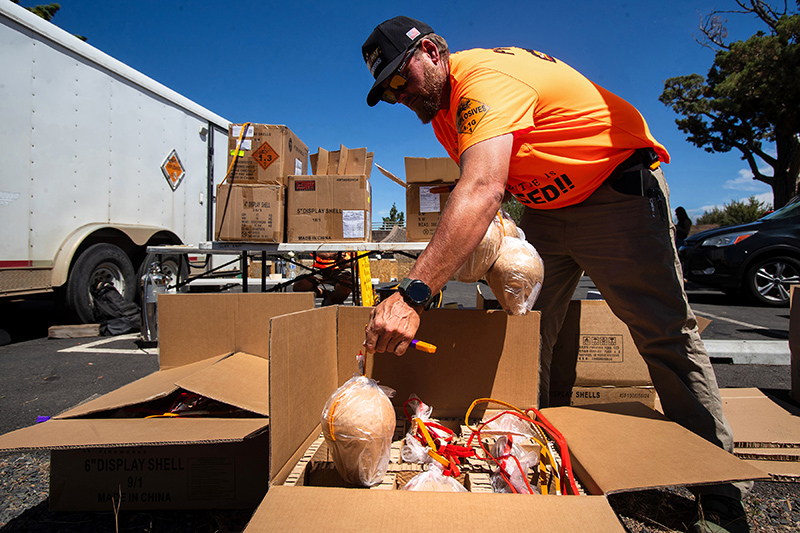Middle Fork of the Willamette Trail
Published 7:16 am Thursday, September 27, 2018

- The sparkling, clear Middle Fork of the Willamette River near Oakridge.
OAKRIDGE —
Those who suffer from claustrophobia — or arachnophobia (fear of spiders), for that matter — might want to think twice before riding the Middle Fork of the Willamette Trail.
The trail’s surroundings at certain times of the year can be so lush and so green, so bursting with plants and trees in their full splendor, that the route can seem downright suffocating as it runs through the thick canopy of the Willamette National Forest.
On a recent trip there, I felt the light brush on my skin as I biked through a spider web. Figuring it was harmless, I rode on — until I noticed a quite large spider dangling from my right handlebar. I’ll admit I was creeped out, and I jumped off my bike to make sure the spider was gone.
At home, I’m known to my family as the spider killer, but that is when they come into our territory. When we venture onto their turf, I’m guessing they would rather not be ripped from their comfortable web by a mountain biker.
Despite the spiders, the mosquitoes (bring bug spray!), and the somewhat overwhelming vegetation, the Middle Fork is a trail that should not be missed by mountain bikers looking for a little more adventure and a change of pace from the more barren High Desert trails in Central Oregon.
Barely half a foot wide in certain places, the 30-mile-long trail cuts through green meadows, moss-covered Douglas fir trees and numerous creeks. The northwestern terminus of the trail at Sand Prairie Campground is located about 12 miles from Oakridge, the mountain-biking mecca about 40 miles southeast of Eugene and 100 miles from Bend on state Highway 58.
Last month I drove south of Oakridge past Hills Creek Lake to Sand Prairie, about a two-hour trip from Bend. The Middle Fork of the Willamette is not the murky Willamette River that flows through Eugene and Portland, but rather a sparkling, clear stream. The Middle Fork springs from the ground near Timpanogas Lake just south of Diamond Peak, 43 miles southeast of Oakridge. At about 5,000 feet in elevation, Timpanogas marks the southeast terminus of the Middle Fork Trail, and its highest point.
The first 4 miles of the trail from Timpanogas are steep, extremely technical, expert-only sections where the trail descends sharply. Fortunately, many trailheads and campgrounds are located along Forest Service Road 21, which runs south and east from Oakridge. So bikers can opt for an out-and-back ride from Sand Prairie Campground, located at about 2,000 feet in elevation, or shuttle up to a starting point of their choosing.
My plan was for an out-and-back ride from Sand Prairie, hoping to cover about 20 miles.
The trail started out skirting the river then took me away from the water, though I was still riding through greenery and shaded by the forest canopy on a warm day when temperatures would reach the mid-80s. (The Middle Fork is a good trail to ride during the summer because most of it is in the shade.) Purple and yellow wildflowers lined much of the trail as it passed through numerous meadows, adding to the stunning scenery of the remote forest.
The trail includes some steep climbs here and there, but nothing too demanding. The rugged and rolling nature of the trail, though, does make it hard to find some rhythm while pedaling through the deep woods. Many trails in Central Oregon are designed with flow in mind, as modern-day mountain bikers seek the thrill of bermed corners, jumps and other features. But the Middle Fork Trail was designed to simply follow the river, giving it a more backcountry feel.
Designated as a National Recreation Trail in 2007, the Middle Fork of the Willamette Trail was built in the late 1980s and early ’90s as a multipurpose trail that is also popular among hikers and horseback riders.
The trail is somewhat similar to the North Umpqua River Trail and the McKenzie River Trail, other National Recreation Trails in Western Oregon, but the Middle Fork is less renowned among mountain bikers.
The trail requires several bridge crossings over creeks or the Willamette itself. Most of the bridges are narrow, forcing bikers to carry their bikes or put them up on wheelies in front of them during the walk across.
After about 10 miles and three hours of riding, I decided to turn around and pedal back toward Sand Prairie. The ride back was noticeably faster, and the added wind helped me to cool down on the hot day.
A nice feature of the Middle Fork Trail is that if mountain bikers get too exhausted or overwhelmed by the rugged nature of the trail they can always cheat and make their way over to the much smoother Forest Service Road 21, which runs parallel to most of the trail.
I resisted the urge to do that. Instead, I stayed on the singletrack and made it back to Sand Prairie about five hours after starting out.
For those looking to skip some of the uphill, Oregon Adventures in Oakridge (oregon-adventures.com) offers shuttles and guides along the hundreds of miles of singletrack in the area, including the Middle Fork and Alpine trails. The company also hosts its annual Mountain Bike Oregon Festival in Oakridge, scheduled this year for July 14-16.
— Reporter: 541-383-0318,
mmorical@bendbulletin.com
Middle Fork of the Willamette Trail
Directions: From Oakridge (about two hours from Bend), travel east on state Highway 58 for 2 miles to Kitson Springs County Road. Turn right and proceed half a mile to Forest Service Road 21. Turn right and follow for 11 miles to Sand Prairie Campground. Trail can be ridden as an out and back from the campground, or bikers can shuttle up to numerous other access points along the trail.
Trail features: Narrow singletrack cutting through lush, green forest of mixed conifer, cottonwood and big-leaf maple along the Middle Fork of the Willamette River. Several creek crossings add to the character of the trail. The trail is relatively flat, but the riding on the uppermost 4 miles is extremely steep and technical.
Length: Total length of the trail — from Timpanogas Lake to Sand Prairie Campground — is about 30 miles. The trail can be accessed from many points along Forest Service Road 21 for shorter rides.
Rating: Aerobically intermediate and technically intermediate, depending on length of ride.
Editor’s note: Mountain Bike Trail Guide, by Bulletin outdoors writer Mark Morical, features various trails in Central Oregon and beyond. The trail guide appears in Sports on alternating Thursdays through the riding season.








